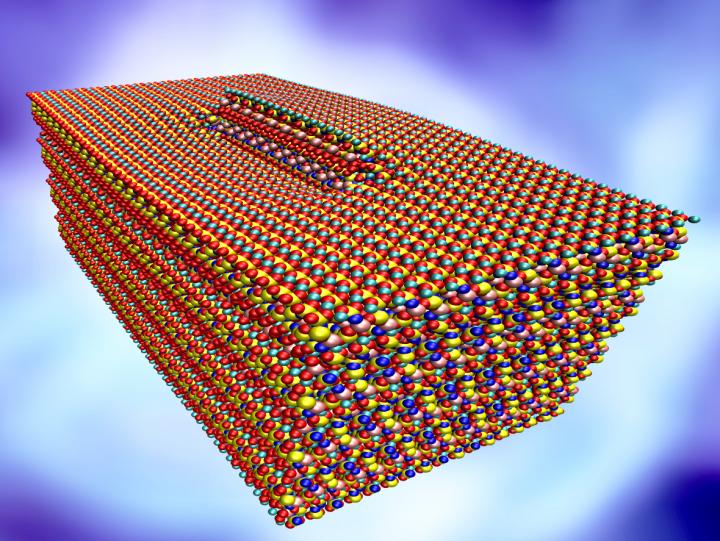

A screw dislocation disrupts the regular rows of atoms in tobermorite, a naturally occurring crystalline analog to the calcium-silicate-hydrate that makes up cement. Rice University scientists simulated tobermorite to see how it uses dislocations to relieve stress when used in concrete.
Credit: Multiscale Materials Laboratory/Rice University
Concrete isn't thought of as a plastic, but plasticity at small scales boosts concrete's utility as the world's most-used material by letting it constantly adjust to stress, decades and sometimes even centuries after hardening. Rice University researchers are a step closer to understanding why.
The Rice lab of materials scientist Rouzbeh Shahsavari performed an atom-level computer analysis of tobermorite, a naturally occurring crystalline analog to the calcium-silicate-hydrate (C-S-H) that makes up cement, which in turn holds concrete together. By understanding the internal structure of tobermorite, they hope to make concrete stronger, tougher and better able to deform without cracking under stress.
Their results appear this week in the American Chemical Society journal ACS Applied Materials and Interfaces.
Tobermorite, a key element in the superior concrete Romans used in ancient times, forms in layers, like paper stacks that solidify into particles. These particles often have screw dislocations, shear defects that help relieve stress by allowing the layers to slide past each other. Alternately, they can allow the layers to slip only a little before the jagged defects lock them into place.
The researchers built the first computer models of tobermorite “super cells” with dislocations either perpendicular to or in parallel with layers in the material, and then applied shear force. They found that defect-free tobermorite deformed easily as water molecules caught between layers helped them glide past each other.
But in particles with screw defects, the layers only glided so far before being locked into place by the tooth-like core dislocations. That effectively passed the buck to the next layer, which glided until caught, and so on, relieving the stress without cracking.
This “step-wise defect-induced gliding” around the particle's core makes it more ductile and able to adjust to stress, Shahsavari said, an assistant professor of civil and environmental engineering and materials science and nanoengineering.
“The insight we get from this study is that unlike the common intuition that defects are detrimental for materials, when it comes to complex layered crystalline systems such as tobermorite, this is not the case,” said Shahsavari, “Rather, the defects can lead to dislocation jogs in certain orientations, which acts as a bottleneck for gliding, thus increasing the yield stress and toughness.
“These latter properties are key to design concrete materials, which are concurrently strong and tough, two engineering features that are highly desired in several applications. Our study provides the first report on how to leverage seemingly weak attributes — the defects — in cement and turn them to highly desired properties, high strength and toughness.”
Shahsavari said he hopes the work will provide design guidelines for developing stronger, tougher concrete and other complex materials.
###
Rice postdoctoral researcher Ning Zhang is lead author of the paper and Philippe Carrez, a professor at the Lille University of Science and Technology, Villeneuve d'Ascq, France, is a co-author.
The National Science Foundation (NSF) supported the research. Computing resources were supplied by the National Institutes of Health and an IBM Shared University Research award in partnership with CISCO, Qlogic and Adaptive Computing, as well as Rice's NSF-supported DAVinCI supercomputer administered by Rice's Center for Research Computing and were procured in partnership with Rice's Ken Kennedy Institute for Information Technology.
Read the abstract at http://pubs.
This news release can be found online at http://news.
Follow Rice News and Media Relations via Twitter @RiceUNews
Related materials:
Multiscale Materials Laboratory home page: http://rouzbeh.
George R. Brown School of Engineering: http://engineering.
Rice Department of Civil and Environmental Engineering: http://www.
Rice Department of Materials Science and NanoEngineering: https:/
Located on a 300-acre forested campus in Houston, Rice University is consistently ranked among the nation's top 20 universities by U.S. News & World Report. Rice has highly respected schools of Architecture, Business, Continuing Studies, Engineering, Humanities, Music, Natural Sciences and Social Sciences and is home to the Baker Institute for Public Policy. With 3,910 undergraduates and 2,809 graduate students, Rice's undergraduate student-to-faculty ratio is 6-to-1. Its residential college system builds close-knit communities and lifelong friendships, just one reason why Rice is ranked No. 1 for happiest students and for lots of race/class interaction by the Princeton Review. Rice is also rated as a best value among private universities by Kiplinger's Personal Finance. To read “What they're saying about Rice,” go to http://tinyurl.















